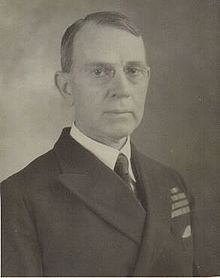Years of service 1896–1946 Name Dudley Knox | ||
 | ||
Allegiance United States of America Battles/wars Spanish–American WarBoxer RebellionWorld War IWorld War II Books The Eclipse of American Sea Power Battles and wars | ||
Commodore Dudley Wright Knox (21 June 1877 – 11 June 1960) was an officer in the United States Navy during the Spanish–American War and World War I. He was also a prominent naval historian, who for many years oversaw the Navy Department's historical office, now named the Naval History and Heritage Command.
Contents
Early life
Born in Fort Walla Walla, Washington, Knox attended school in Washington, D.C., and graduated from the United States Naval Academy on 5 June 1896.
Professional career
During the Spanish–American War, he served aboard the screw steamer Maple, a tender, in Cuban waters. He commanded the gunboats Albay and Iris during the Philippine–American War and the latter during the Chinese Boxer Rebellion. He then commanded three of the Navy's first destroyers: Shubrick, Wilkes and Decatur before commanding the First Torpedo Flotilla. During the cruise of the "Great White Fleet," sent around the world by President Theodore Roosevelt, he was ordnance officer of battleship Nebraska (BB-14).
On May 18, 1908, while the Great White Fleet rested in San Francisco, California, he married Lily Hazard McCalla (1878–1965), the daughter of Rear Admiral Bowman H. McCalla. Lily's brother-in-law, Arthur MacArthur III, was Dudley's classmate at the Naval Academy. They had one son, Dudley Sargent Knox, (1909-1968).
He attended the Naval War College in 1912–13, and after graduation became the aide to Captain William Sims, commanding the Atlantic Torpedo Flotilla. In 1915, Knox became a leading figure in developing naval operational doctrine by publishing an influential article in the U.S. Naval Institute Proceedings. He was Fleet Ordnance Officer in both Atlantic and Pacific, served in the Office of Naval Intelligence, and commanded the Guantanamo Bay Naval Station. In November 1917, he joined the staff of Admiral William Sims, Commander of U.S. Naval Forces in European Waters, and earned the Navy Cross for "distinguished service" serving as Aide in the Planning Section, and later in the Historical Section. He was promoted to Captain on 1 February 1918.
After returning to the United States in March 1919, he served for a year on the faculty of the Naval War College, when he was a key figure on the Knox-King-Pye Board that examined professional military education. In 1920–21, he commanded the armored cruiser Brooklyn (ACR-3), then the protected cruiser Charleston (C-22) before resuming duty in the Office of the Chief of Naval Operations.
In 1920, Knox first began his work as a naval publicist, serving as naval editor of the Army and Navy Journal until 1923. He became the naval correspondent of the Baltimore Sun from 1924 to 1946, and naval correspondent of the New York Herald Tribune in 1929. Transferred to the Retired List of the Navy on 20 October 1921, he continued on active duty, simultaneously serving as Officer in Charge, Office of Naval Records and Library, and as Curator for the Navy Department. Knox played a key role in creating the Naval Historical Foundation. Early in World War II, he was assigned additional duty as Deputy Director of Naval History.
For a quarter of a century, his leadership inspired diligence, efficiency, and initiative while he guided, improved, and expanded the Navy's archival and historical operations. His personal connections to President Roosevelt, Fleet Admiral Ernest J. King, and other senior leaders in the Navy Department allowed him to play an instrumental role behind the scenes in the years leading up to and during World War II.
His writings included his first book The Eclipse of American Sea Power (1922) and A History of the United States Navy (1936), the latter recognized as "the best one-volume history of the United States Navy in existence." Through his personal connection with President Roosevelt, he was able to publish key, multi-volume collections of documents on naval operations in The Quasi-War with France in 1798–1800, the First Barbary War and the Second Barbary War.
Advanced to Commodore on 2 November 1945, he was awarded the Legion of Merit for "exceptionally meritorious conduct" while directing the correlation and preservation of accurate records of the U.S. naval operations in World War II, thus protecting this vital information for posterity.
Knox was relieved of all active duty 26 June 1946. He died in Bethesda, Maryland, on 11 June 1960. His papers in 24 boxes are in the Manuscript Division of the Library of Congress.
The United States Navy ship USS Knox (FF-1052) was named for him.
Published works
Decorations
Commodore Dudley Wright Knox's ribbon bar:
